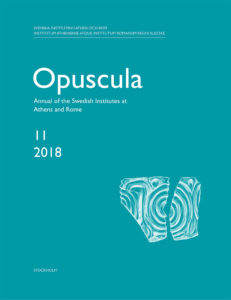 Opuscula is published by the Swedish Institutes at Athens and Rome, with the aid of a grant from the Swedish Research Council. Distributed by Eddy.se AB. View journal at ERIH PLUS. All content available with open access.
Opuscula is published by the Swedish Institutes at Athens and Rome, with the aid of a grant from the Swedish Research Council. Distributed by Eddy.se AB. View journal at ERIH PLUS. All content available with open access.
The hand gesture and symbols of Sabazios
By Susanne Berndt (Stockholm University).
Abstract
The material evidence left from the cult of Sabazios is meagre, apart from sculpted bronze hands dating to the Roman Empire. The hand is held in a certain pose, the so-called benedictio Latina gesture, and the hand was often covered with depictions of various objects and symbols. The bronze hands were probably attached to staffs and carried around in processions. This practice most likely spread via the channels of the Roman army during the Early Imperial period, but the gesture existed much earlier. The gesture is found on Attic black- and red-figured pottery, and is frequently associated with Hermes in his role as instructor and Psychopompos. From the beginning of the Hellenistic period the gesture was mainly used as an indication of speech, and for knowledge transmitted through speech. There are several examples of how the gesture was used to indicate the knowledge revealed through the initiations of mystery cults. Hermes is closely associated with Sabazios and is represented on the bronze hands, probably because of his role as instructor and Psychopompos; i.e. the position played by the mystagogue in the Sabazian mysteries. The gesture of the hands simply denoted the knowledge acquired through the initiation. The symbols on the hands are often associated with the Underworld, and it is suggested that knowledge acquired in the Sabazian mysteries dealt with life after death and the Underworld.
Download PDF - Size: 1.40 MB - Downloads: 1,201 (since 2023)
Bibliographical information
Susanne Berndt, ’The hand gesture and symbols of Sabazios’, Opuscula. Annual of the Swedish Institutes at Athens and Rome (OpAthRom) 11, Stockholm 2018, 151–168. ISSN: 2000-0898. ISBN: 978-91-977799-0-6. https://doi.org/10.30549/opathrom-11-08

No Comments
Comments are closed.